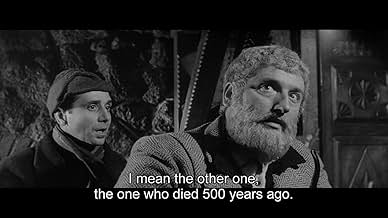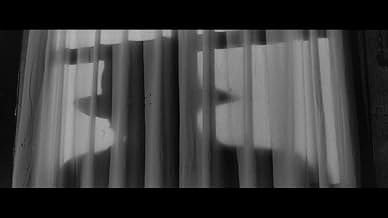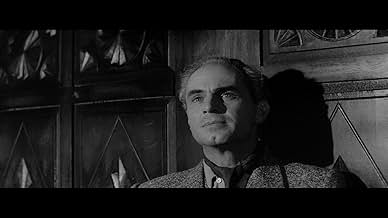IMDb RATING
5.9/10
699
YOUR RATING
When violent crime strikes a tiny hamlet, the townsfolk suspect the distant relative of a sadistic 17th century baron who cursed the village.When violent crime strikes a tiny hamlet, the townsfolk suspect the distant relative of a sadistic 17th century baron who cursed the village.When violent crime strikes a tiny hamlet, the townsfolk suspect the distant relative of a sadistic 17th century baron who cursed the village.
Ana Castor
- Lida
- (as Anna Astor)
Manuel Alexandre
- Theo
- (uncredited)
Emilio Alonso
- Police Sergeant
- (uncredited)
José Carlos Arévalo
- Helmund
- (uncredited)
José Luis Coll
- Hotel Guest
- (uncredited)
Fernando Delgado
- Karl Steiner
- (uncredited)
María Francés
- Elisa von Klaus
- (uncredited)
Serafín García Vázquez
- Hansel
- (uncredited)
Marius Lesoeur
- Man Blocking Traffic on Bridge
- (uncredited)
Miguel Madrid
- Fritz, Hanburg Hotel Concierge
- (uncredited)
Ángel Menéndez
- Doctor Kalman
- (uncredited)
Turia Nelson
- Dorian Vincet
- (uncredited)
Joaquín Pamplona
- Steiner's Editor
- (uncredited)
Featured reviews
A true deity to some
not much more than a lame plagiarist to others. One statement everyone must agree with is that Jess Franco is one of the most creative and busiest men in the film industry. With a repertoire of over 180 movies as a director, writer, composer and often also editor, Jess Franco always was an important pivot figure for the European cult cinema. Especially his earliest films are sublime independent motion pictures, since he afterwards merely followed popular trends (like the slasher films with 'Bloody Moon') or started making moneymaking sleaze films (nunsploitation, babes-in-prison flicks
). The Sadistic Baron Von Klaus belongs among his finest achievements according to me at least and only was his second effort in the horror field, immediately after the terrific 'Awful Dr. Orloff'. The film is set in a quiet little German town, still haunted by ghosts from the past. There once lived a maniacal Baron who committed several despicable felonies like murder, rape etc
When a young girl is found murdered and another one goes missing, the police immediately suspect the Baron's descendant Max von Klaus. But
is he really the murderer, because all the women disappear from the nearby hotel-brother visited by adulterous men.
Talking about style, this film has quite a lot in common with The Awful Dr. Orloff. It's a slowly developing and atmospheric murder mystery. Even though there aren't that many suspects for the murders, Franco manages to keep up the suspense by giving away only a few clues. There's very few action (apart from a cool manhunt through the eerie old streets) but the dialogues are great and the black-and-white cinematography makes the entire film look ominous and paralyzing. Howard Vernon, star in many wicked Franco films, shines as the creepy looking Von Klaus. This early, story-driven Franco terror is recommended in case you're a Eurocult-hunter. Avoid if you're only into loud, computerized splatter.
Talking about style, this film has quite a lot in common with The Awful Dr. Orloff. It's a slowly developing and atmospheric murder mystery. Even though there aren't that many suspects for the murders, Franco manages to keep up the suspense by giving away only a few clues. There's very few action (apart from a cool manhunt through the eerie old streets) but the dialogues are great and the black-and-white cinematography makes the entire film look ominous and paralyzing. Howard Vernon, star in many wicked Franco films, shines as the creepy looking Von Klaus. This early, story-driven Franco terror is recommended in case you're a Eurocult-hunter. Avoid if you're only into loud, computerized splatter.
One of Franco's classiest and most skillful films.
It's also one of his best written films. The characters are consistent and memorable. The actors really get into character because there is a well written character for them to portray. Even the police detective is not a 100% buffoon and is able to say intelligent things some of the time.
The black & white is gorgeous but not as gorgeous as some of his other black & white films. The cinematography is great and uses and variety of shots very well to tell the story.
The story itself was rather predictable. And I wish the villain had more of a chance to shine in their madness at the end of the film.
It's also one of his best written films. The characters are consistent and memorable. The actors really get into character because there is a well written character for them to portray. Even the police detective is not a 100% buffoon and is able to say intelligent things some of the time.
The black & white is gorgeous but not as gorgeous as some of his other black & white films. The cinematography is great and uses and variety of shots very well to tell the story.
The story itself was rather predictable. And I wish the villain had more of a chance to shine in their madness at the end of the film.
Here's another early Franco, rescued for DVD, that proves that he was once a director to be reckoned with. Creepy B&W atmosphere, with individualistic characters spouting often witty dialogue (not unlike the Edgar Wallace krimis). Highly reminiscent of his earlier Orloff film (in fact, some of the scene settings and lighting techniques look identical), this one pushes the sadism further with a knockout torture scene of a sexy barmaid that must have really pushed the limits in the early 60's. The jazzy score and the usual cabaret scenes help keep the film light despite the preponderance of dialogue scenes.
My last-viewed Jess Franco movie had been the supremely silly CELESTINE, AN ALL-ROUND MAID (1974); I was therefore relieved to catch something from his initial black-and-white phase, not that the end result proved exactly satisfying (especially since, at 95 minutes, it tends to drag somewhat). Incidentally, since I missed out on celebrating the notorious Spanish director's 80th birthday last year, I was ready to make amends now with as many as 15 Franco titles scheduled for this month (10 of them will even be first-time viewings) and 5 more that are in a way related or somewhat similar in theme and approach!
This pretty much evokes the same mood as the superior THE DIABOLICAL DOCTOR Z (1965): in fact, I think his style kept improving or, if you like, gradually became more polished and reached its zenith in that film before he turned his attention to color and, with the new-found permissiveness, his erotic concern also came to the fore (which, in my book, was not a good thing but that argument is better left for another day and another film). By the way, even if these early efforts were officially Spanish productions, they are easier to come by in their slightly-altered (emphasizing the nudity quotient, sometimes gratuitously so, which on its home ground would have been repressed by the State Censorship Board!) French versions via the Eurocine company; thankfully, this copy retains the French dialogue which is (by far) superior to the English dubs though the original Spanish title, which translates to THE HAND OF A DEAD MAN, is decidedly classier than the one it got stuck with here!
The narrative is quite typical and, in fact, his later Dracula'S DAUGHTER (1972; no relation to the 1936 Universal horror classic) makes for a direct remake of it: if anything, Franco frequently ingeniously (or is that ingenuously) revamped a plot that he felt a particular affinity with or, perhaps to put it more crudely, a formula that seemed to work – personally, I find his most interesting double-feature in this vein to be the blood-sucking combo of COUNT Dracula (1969; which I will be revisiting presently since I have only caught it thus far in the slightly extended but unsubtitled Spanish-language version) and VAMPYROS LESBOS (1970). Anyway, this is not bad but it does not reach any great heights either: we have a series of murders which seem to be tied to one particular family and, apparently, are a reprise of a killing spree perpetrated by an ancestor. The obvious suspect is the new head of the family (played by the sinister-looking and Franco regular Howard Vernon) but, as it turns out, it is someone else who had so far been depicted as reasonably sympathetic and virtuous – that said, there are clues to his true nature when he barely bats an eyelid over the death of his mother unless this was a combination of bad direction and listless acting (with Franco, you are never really sure)! In the end, he voluntarily joins his progenitor into the swamps (again, foreshadowing a subsequent picture by the director, namely A VIRGIN AMONG THE LIVING DEAD {1971}).
The film contains elements which would soon become trademarks such as the dysfunctional family unit, the cabaret act and the Police procedural, yet Franco is most inspired when he tries to emulate his idol Orson Welles – particularly a night-time chase through the streets marked by tilted camera angles! As I said, on the other hand, the would-be titillating inserts do not really add anything to the proceedings or the film's overall assessment: indeed, these so-called "Continental Versions" were never more than sensation-seeking exploitation ploys and, at this juncture, come across as mere curiosities!
This pretty much evokes the same mood as the superior THE DIABOLICAL DOCTOR Z (1965): in fact, I think his style kept improving or, if you like, gradually became more polished and reached its zenith in that film before he turned his attention to color and, with the new-found permissiveness, his erotic concern also came to the fore (which, in my book, was not a good thing but that argument is better left for another day and another film). By the way, even if these early efforts were officially Spanish productions, they are easier to come by in their slightly-altered (emphasizing the nudity quotient, sometimes gratuitously so, which on its home ground would have been repressed by the State Censorship Board!) French versions via the Eurocine company; thankfully, this copy retains the French dialogue which is (by far) superior to the English dubs though the original Spanish title, which translates to THE HAND OF A DEAD MAN, is decidedly classier than the one it got stuck with here!
The narrative is quite typical and, in fact, his later Dracula'S DAUGHTER (1972; no relation to the 1936 Universal horror classic) makes for a direct remake of it: if anything, Franco frequently ingeniously (or is that ingenuously) revamped a plot that he felt a particular affinity with or, perhaps to put it more crudely, a formula that seemed to work – personally, I find his most interesting double-feature in this vein to be the blood-sucking combo of COUNT Dracula (1969; which I will be revisiting presently since I have only caught it thus far in the slightly extended but unsubtitled Spanish-language version) and VAMPYROS LESBOS (1970). Anyway, this is not bad but it does not reach any great heights either: we have a series of murders which seem to be tied to one particular family and, apparently, are a reprise of a killing spree perpetrated by an ancestor. The obvious suspect is the new head of the family (played by the sinister-looking and Franco regular Howard Vernon) but, as it turns out, it is someone else who had so far been depicted as reasonably sympathetic and virtuous – that said, there are clues to his true nature when he barely bats an eyelid over the death of his mother unless this was a combination of bad direction and listless acting (with Franco, you are never really sure)! In the end, he voluntarily joins his progenitor into the swamps (again, foreshadowing a subsequent picture by the director, namely A VIRGIN AMONG THE LIVING DEAD {1971}).
The film contains elements which would soon become trademarks such as the dysfunctional family unit, the cabaret act and the Police procedural, yet Franco is most inspired when he tries to emulate his idol Orson Welles – particularly a night-time chase through the streets marked by tilted camera angles! As I said, on the other hand, the would-be titillating inserts do not really add anything to the proceedings or the film's overall assessment: indeed, these so-called "Continental Versions" were never more than sensation-seeking exploitation ploys and, at this juncture, come across as mere curiosities!
The Sadistic Baron Von Klaus is a very early Jess Franco film. It comes from a phase in which he worked in black and white productions. It's about the legend of a long dead, sadistic 17th century Baron who rises from a swamp to kill women. Naturally, in the present day, a series of murders ensues in the vicinity of his castle.
This one seemed to stand out for two reasons for me. Firstly, it was nice to see a Franco production sporting such lush black and white cinematography. It really adds a layer of class to proceedings and Franco is not always a director who you would associate with good taste! Secondly, and perhaps more typically of this director, it contained an S&M scene that must be the raciest soft-core sex scene I have seen from a film this old – its full-on topless nudity and kinkiness all the way here and that was rather fun to behold in a film of this vintage. Aside from these two differentiating factors this is a somewhat plodding and overlong murder-mystery that most probably falls under the bracket of the German Krimi sub-genre. It stars Franco regular actor Howard Vernon who once again stands head and shoulders above everybody else from a thespian perspective. All-in-all, an interesting if flawed early Franco.
This one seemed to stand out for two reasons for me. Firstly, it was nice to see a Franco production sporting such lush black and white cinematography. It really adds a layer of class to proceedings and Franco is not always a director who you would associate with good taste! Secondly, and perhaps more typically of this director, it contained an S&M scene that must be the raciest soft-core sex scene I have seen from a film this old – its full-on topless nudity and kinkiness all the way here and that was rather fun to behold in a film of this vintage. Aside from these two differentiating factors this is a somewhat plodding and overlong murder-mystery that most probably falls under the bracket of the German Krimi sub-genre. It stars Franco regular actor Howard Vernon who once again stands head and shoulders above everybody else from a thespian perspective. All-in-all, an interesting if flawed early Franco.
Did you know
- TriviaOnly career nude scene for Gogó Rojo.
- ConnectionsReferenced in Kika (1993)
Details
- Runtime
- 1h 40m(100 min)
- Color
- Sound mix
- Aspect ratio
- 2.35 : 1
Contribute to this page
Suggest an edit or add missing content


























